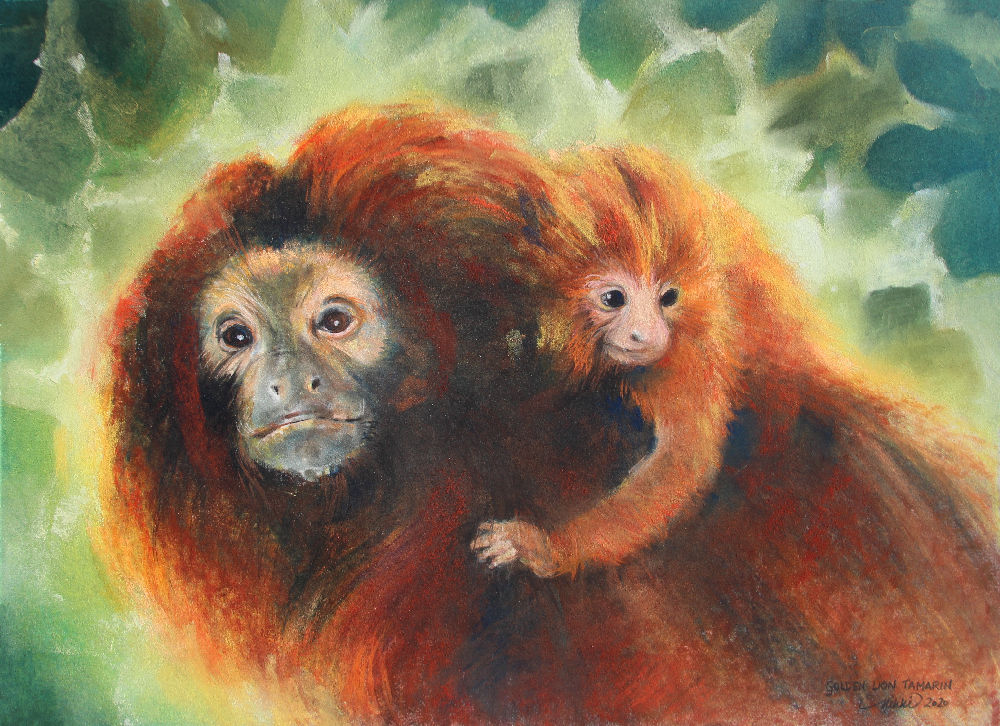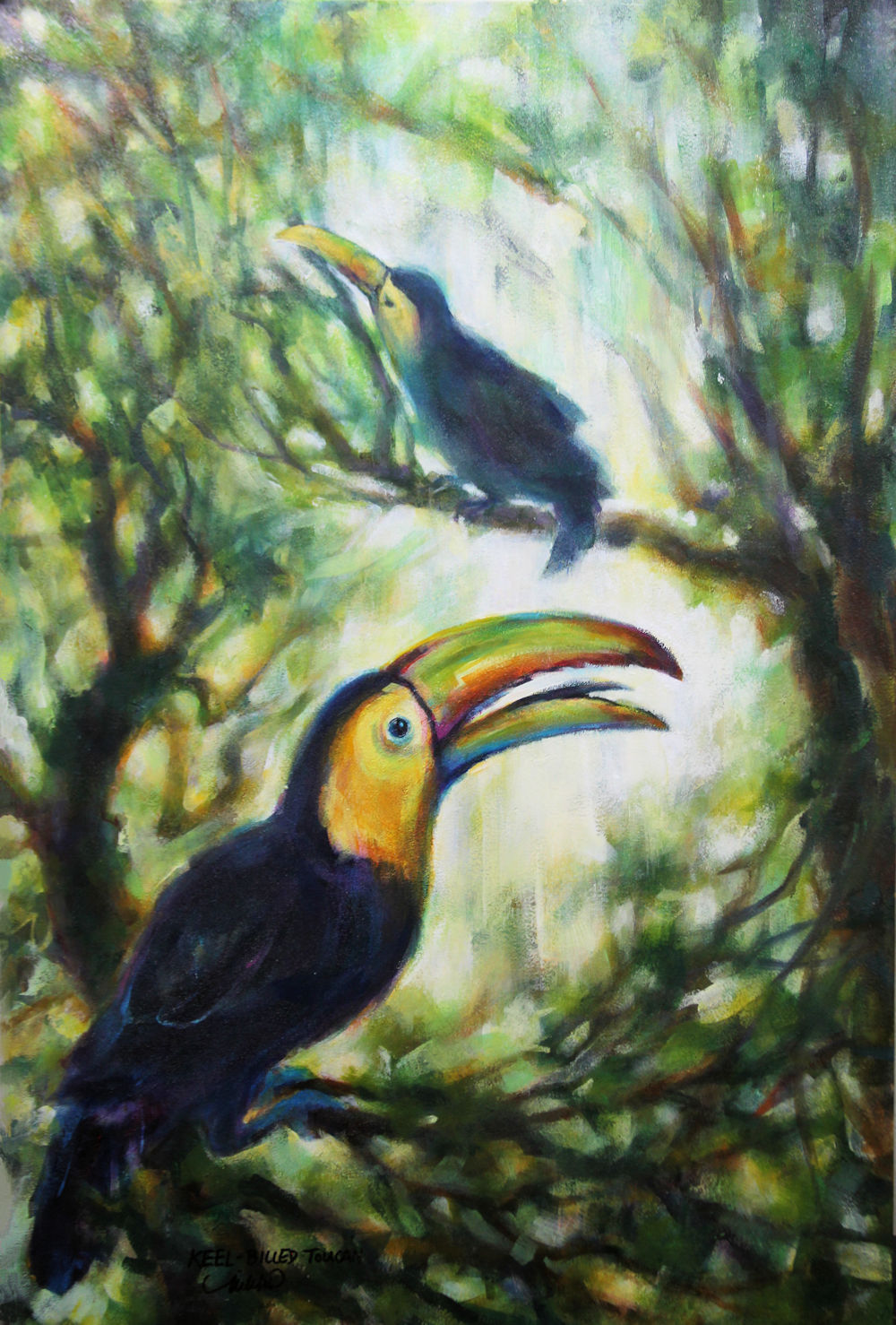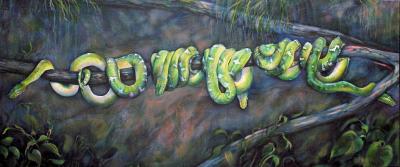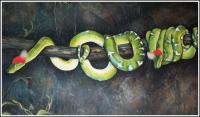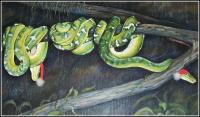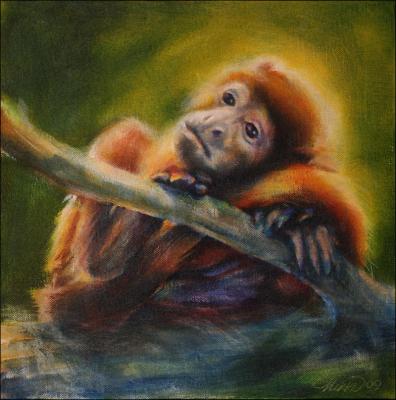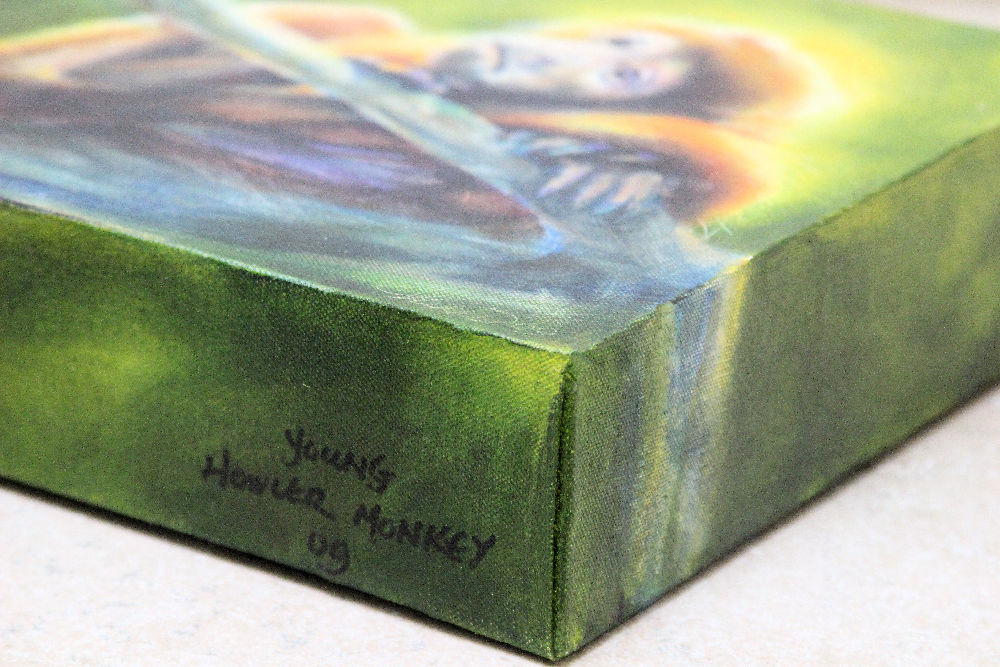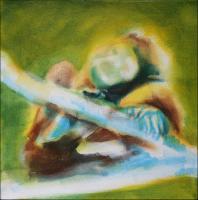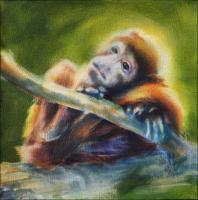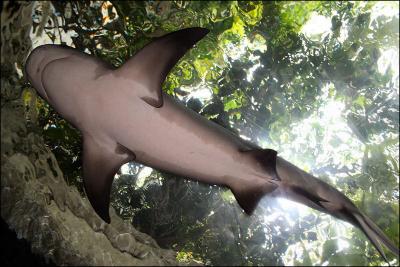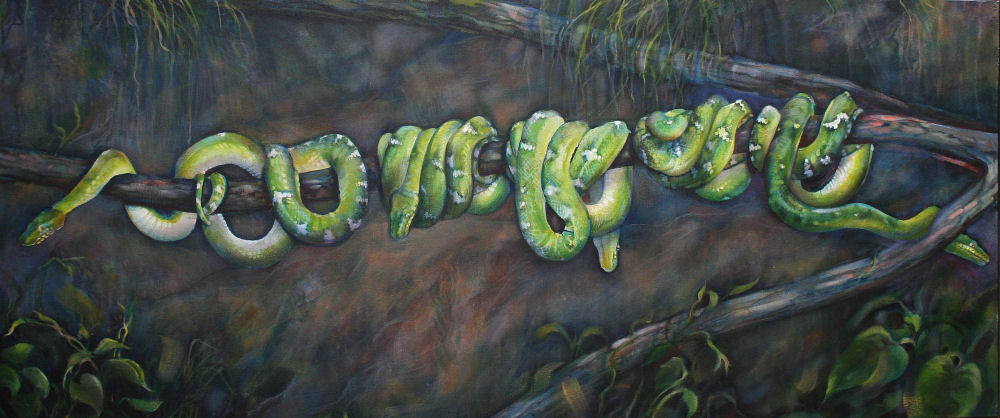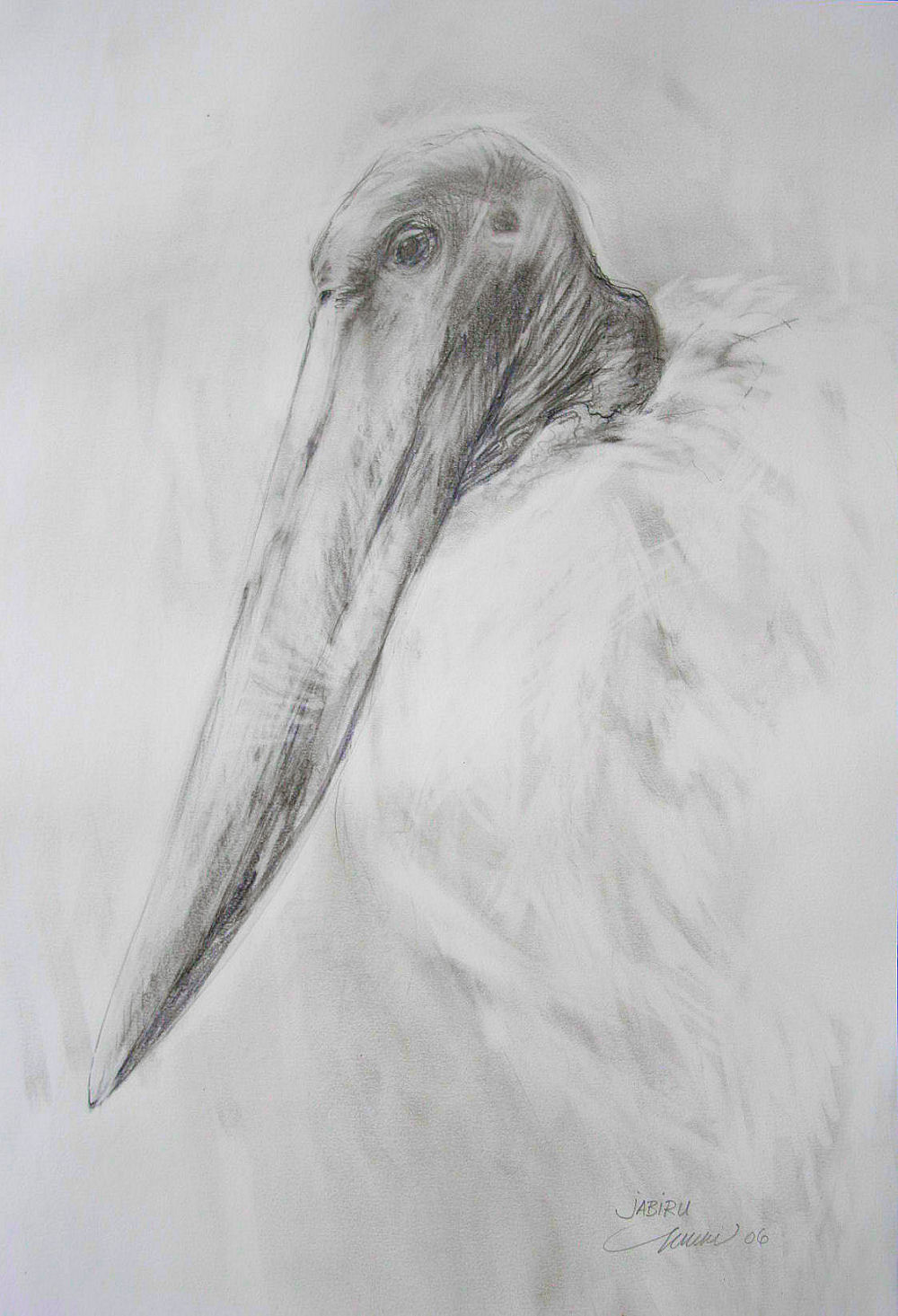Dallas World Aquarium
Precious
Wednesday, May 31st, 2023
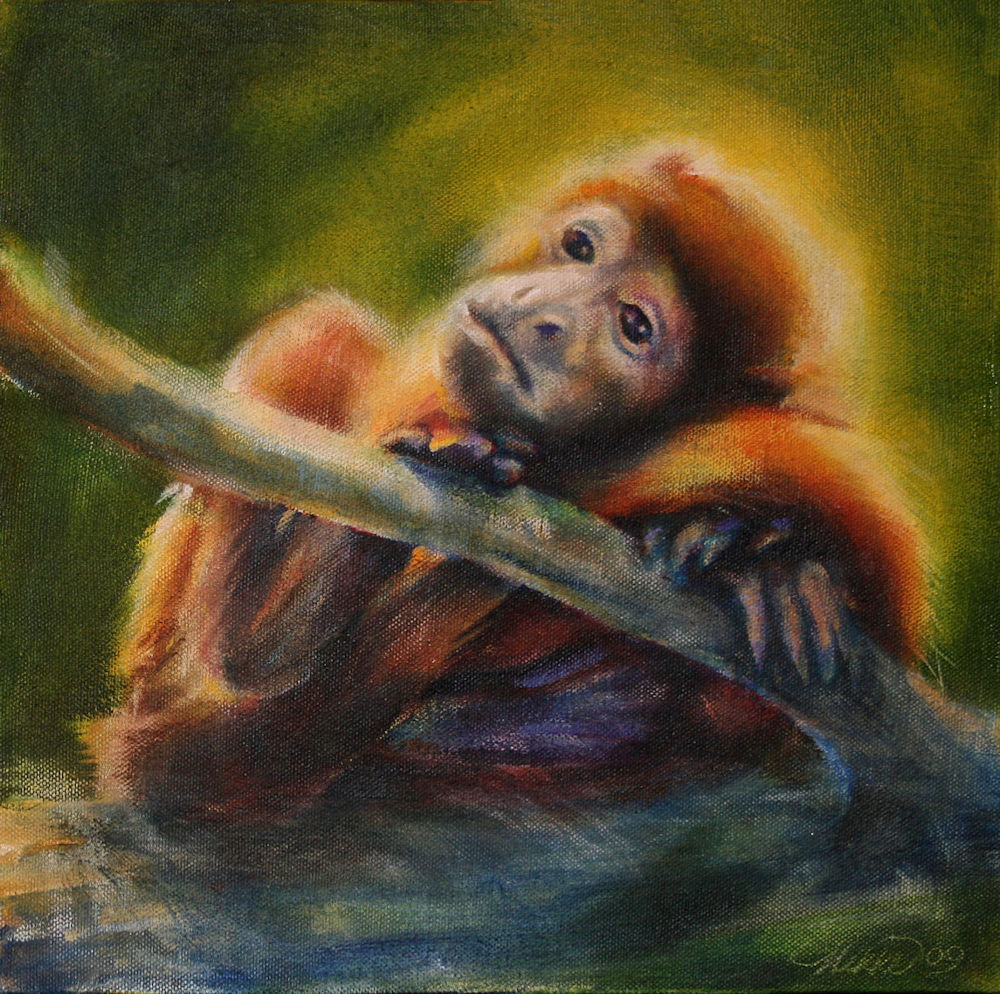
![]() Young Howler Monkey (2009), 11H x 11W x 3D inches acrylics on canvas. Hang on a wall or display on flat surface.
Young Howler Monkey (2009), 11H x 11W x 3D inches acrylics on canvas. Hang on a wall or display on flat surface.
Showcased in Exhibizone’s “Precious” International Online Group Exhibition June 1st – July 31st.
Also previously showed in Biafarin / Exhibizone ‘Kingdom Animalia 2022’July 1-2022 To July 31, 2022.
Golden Lion Tamarin
Sunday, November 8th, 2020
Golden Lion Tamarin at the Dallas World Aquarium, Texas – 18H x 24W inches soft pastels on 90 lb watercolor paper.
These sweet little primates are only about 10 inches and 1.5 lb full-grown. They are considered an endangered species, with an estimated 3,200 confined to areas of tropical rainforest in southeastern Brazil.
Keel-billed Toucans rejuvenated
Saturday, May 16th, 2020
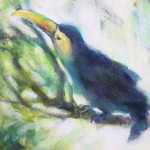
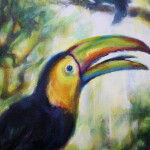 Keel-billed Toucans, seen at the Dallas World Aquarium, when they used to fly around freely there, in front of the waterfall. 29H x 20W x 2D inches acrylics on canvas. This is an older piece not listed back then because I was never happy with it. Using crackle medium to help create a bit of texture, it has been touched up, rejuvenated, and is now for sale.
Keel-billed Toucans, seen at the Dallas World Aquarium, when they used to fly around freely there, in front of the waterfall. 29H x 20W x 2D inches acrylics on canvas. This is an older piece not listed back then because I was never happy with it. Using crackle medium to help create a bit of texture, it has been touched up, rejuvenated, and is now for sale.
Perpetual painting
Monday, October 5th, 2009
Like music
where silence between the notes sets the rhythm,
not painting is half the work.
 For all artists, the most mysterious question of all might be “is it finished?” , but for the sake of clarity and the examples here I’ll just refer to painters. One popular opinion is that the best painting is one that’s finished quickly; one that retains the artist’s first fresh impressions, otherwise it should be painted over or tossed in the garbage and a new one started immediately. There are solid reasons for not lingering too long on a painting, but in matters of the Art I’m always suspicious when I hear the word should being used in a sentence containing advice. Some art rumors are accepted as absolute when they could stand some explanation. It can be confusing enough for the experienced, but especially for beginners looking for ground rules and a map to follow.
For all artists, the most mysterious question of all might be “is it finished?” , but for the sake of clarity and the examples here I’ll just refer to painters. One popular opinion is that the best painting is one that’s finished quickly; one that retains the artist’s first fresh impressions, otherwise it should be painted over or tossed in the garbage and a new one started immediately. There are solid reasons for not lingering too long on a painting, but in matters of the Art I’m always suspicious when I hear the word should being used in a sentence containing advice. Some art rumors are accepted as absolute when they could stand some explanation. It can be confusing enough for the experienced, but especially for beginners looking for ground rules and a map to follow.
In Art though, for every should there is another option. The same suggestions don’t work for everyone. Have you ever felt guilty or embarrassed – even ashamed – because you took a painting too far? I have, but it’s only when I’ve compared my work and methods to others’ judgment that I should’ve quit while I was ahead…and guilt has no business hanging around in our daily work if it isn’t useful! Frustration can be an excellent motivator if it’s allowed to be.
If it’s going to make sense – not exclusively the sole intention – every painting reaches stages where we need to make the call to leave it alone and say it’s finished, or proceed; stages where placing one more mark means the entire painting has to change and be brought up to par around it. If things that need correcting are not dealt with honestly, the work will not be as successful as it could be. There are phases in each painting that are truly intimidating, when painting is anything but leisurely; when we’re faced with: do we climb that mountain or not?
A lot of Plein Aire artists swear that their methods of painting outdoors on-site produce the highest quality work. The limitations of sunlight, location, outdoor temperatures and so on, mean that to finish successfully they need to splash down a lot of information within a short period of time. Doing so, when the thinking brain is disengaged and just responding to the subject, a lot of amazing unintentional surprises show up in the painting. Spontaneity and spurts of enthusiasm for being fully in the present tense can bring great results that need no further efforts at the end of the day. Plein Aire artists are in a field of their own (literally too!).
It’s a curious thing how creativity warps and reforms into amazing things when pressure is applied. Many people who aren’t artists will agree that the greatest ideas can occur when under pressure to produce them. For those who have orders to complete, at its best the challenge is like a beautiful sort of panic, where there’s an understanding of the time restrictions while fully trusting that whatever needs to happen is going to be successful. The abilities are less trustworthy when the pace and demand for finished work increases, time allotted decreases and the quality of the product diminishes. If this imbalance continues over extended periods of time, like years, sloppy and care-less habits take hold too easily. If there is work that must be accomplished though, these things can be controlled to some extent –this is one benefit of pushing personal boundaries: it puts tenacity to practice – but creativity is fickle and that’s a fact.
What has all that got to do with the question about finishing? The best paintings are not necessarily those that are finished in a few hours or a day. There are other purposes for painting besides finishing it to admire, be admired or to sell. Nothing replenishes the quality of our creative energy like being lost in the timeless, pure enjoyment of study and detail for no reason in particular. “The Zone” is like an addiction where the high is fairly elusive but we’re compelled compulsively to track it down again and again, discovering and rediscovering the source of it all. One painting could be someone’s lifetime of work.
I’m saying that if you personally feel you’d like to keep going with a painting for days or years… or never finish, then you ought to follow your own intuition about it. I’m not saying you should. I just recommend considering what other artists say, but also consider each painting as a new experience with new rules, new goals and new circumstances.
Experience, masterpiece to failure, will always apply to future work somehow. That’s the great thing about painting: no time spent searching for answers is ever wasted. It’s all recyclable material! Every decision about finishing – or not – is relative to individuality, and relative to each new painting as it develops your way.
Pushing the boundaries
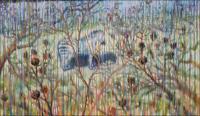 Myrtle At The Zoo, first version, Phase 18, unfinished – Crepe Myrtle branches and seedpods – 20 x 34 x 2 inches acrylics on canvas, gallery wrapped.
Myrtle At The Zoo, first version, Phase 18, unfinished – Crepe Myrtle branches and seedpods – 20 x 34 x 2 inches acrylics on canvas, gallery wrapped.
Work daily March 10th through April 2nd, 2008:
Finished for now…this one needs a rest, and I may or may not return to it. Regardless, I’ve learned a lot ad enjoyed playing with different ideas. It’s been interesting teetering back and forth between frustration and fun, but sometimes that’s what painting is all about. There’s been such a tension over this one as with no other painting, where the urge to throw it away is pitted against the determination to see what could happen. I still like a lot of things in it, such as the technique of dripping paint down the front that I’ve tried in previous paintings. Dripping re-energized the painting and me, and took the work in unexpected directions.
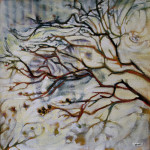 Myrtle At The Zoo, 2nd version – 11 x 11 x 3 inches acrylics on canvas, gallery wrapped sides painted. Many of the issues were worked through on the previous larger version, and I’m pleased with this boxy little painting…still not completely satisfied that I’m finished with this subject because it’s so complex, and it’s like a puzzle that’s nagging at me to figure out, so will probably attempt this same painting at least one more time.
Myrtle At The Zoo, 2nd version – 11 x 11 x 3 inches acrylics on canvas, gallery wrapped sides painted. Many of the issues were worked through on the previous larger version, and I’m pleased with this boxy little painting…still not completely satisfied that I’m finished with this subject because it’s so complex, and it’s like a puzzle that’s nagging at me to figure out, so will probably attempt this same painting at least one more time.
Perpetual painting
Painting animals with distinct and specific characteristics calls for a different approach from start to finish, for example, compared to generic landscapes. The boas are one of my favorite exhibits at the Dallas World Aquarium, downtown Dallas, Texas. The phosphorescent green skin has striking black and white scale patterns along the spine and a turquoise mother-of-pearl overall sheen that’s most visible at certain angles where the body delicately curls and bends, so this painting accumulates finer detail than is typical of my work, except in graphite illustrations.
Emerald Tree Boas, 24 x 57 x 2 inches acrylics on canvas, wrapped sides painted (August, 2005 – ? )
As shown in the thumbnail above, there are only a few small things left to do, a little on the skin then some barely visible brushstrokes in the background like ones that were there in earlier phases, thumbnail…so it really is just about finished, but I’m not in any hurry. Of course I’ll stop in my tracks if you want to buy it!
I like having one painting around that’s going to get the full treatment! Emerald Tree Boas has become like an old friend, even hanging out celebrating holidays in the dining room with the rest of us. It would be nice if this painting could carry enough potency to alter the automatic responses of fear and disgust that are associated with snakes. It just occurred to me that it might be fun to offer the buyer an assortment of hats and hearts and ribbons for different occasions. Where I used tape, instead I’d put magnets on the back and magnets on all the little hats and accessories. It’s a little nutty maybe, but it also opens up the target market a little doesn’t it!
Nature is perfectly imperfect. I paint with acrylics, so if the surface is washed back and scrubbed regularly in areas that need change. Scrubbing paint away with a pot scrubber or wet cloth used to remove paint helps texturize, give atmosphere, and also ensure that paint won’t cake up in areas, unless that’s the intention. More debates about spending too long on a painting are that it stiffens the whole look and feel because 1) it tidies things up too much, and 2) due to the plastic properties of acrylics, if they are allowed to pile up they will harden and shine, no longer catching the tooth of the canvas.
These are all things that can also be used to advantage though. In sports you need to know your opponent… well the same is true here. You can use the buildup to create the effects it produces if that’s what you want to achieve. To keep the canvas texture for as long as possible, paint diluted with gels or water is perfect to start, then as confidence builds, so can your applications of paint. My philosophy is that if things need to change they do, until the word “finished” is loud and clear.
…practice and even failure can be applied to future work…
Howler Monkey
Friday, March 6th, 2009
Young Howler Monkey at the Dallas World Aquarium, 11H x 11W x 3D inches acrylics on canvas, wrapped sides painted. Frame unnecessary. Hang on a wall or display on a flat surface. Signed on the side so as not to impose on the composition.
Work progress detail images shown, scrubbing and scratching away more paint than adding it.
Showcased in the J. Mane Gallery’s Fins, Feathers and Fur 2020 exhibition (post-dated comment).
The changing state of the oceans
Tuesday, April 15th, 2008
Bull Sharks swim overhead in a 40 foot long tunnel in the main floor Mundo Maya exhibit at the Dallas World Aquarium.
Environmental issues are emotional issues. Groups like Greenpeace work aggressively to protect the future of our planet. It’s one way to get the point across, but if we’re talking about changing the habits of the masses, I believe a more gentle approach is more effective. As one who was most assertively involved promoting care for the planet about 20 years ago when developing and selling Original Earthbags, first-hand public reactions and feedback demonstrated that negativity toward the human species does not inspire or motivate some of us to take action; in fact it can even be detrimental to the cause.
There are small things each of us can contribute at any level, habit and practices which, by now most of us are aware of. Zoos, major city aquariums, botanical gardens and similar public spaces naturally affect an awareness of ourselves in relation to Earth and her creatures in a way that permanently affects our perception of life in general. We start incorporating more mindful habits because we want to, not because we are being told we should.
For information about the changing state of the oceans, here is a link to a petition gathering support to increase marine reserves.
Emerald Tree Boas
Saturday, August 4th, 2007
Emerald Tree Boas, 24H x 57W x 2D inches acrylics on canvas, wrapped sides painted, trim frame
This painting accumulated finer detail than is typical of my work, except in graphite illustrations. The Emerald Tree Boas are one of my favorite exhibits at the Dallas World Aquarium (Texas). Their beautiful green skin has striking black and white scale patterns along the spine and a turquoise mother-of-pearl overall sheen that’s visible at certain angles where the body delicately curls and bends.
It would be nice if this painting could carry enough potency to alter the automatic responses of fear and disgust that are associated with snakes. I made Santa hats with construction paper and cotton balls, taping them on as part of our Christmas decorations.
Jabiru
Friday, September 1st, 2006
Jabiru at the Dallas World Aquarium, 24H x 18W inches graphite on paper
Post-dated note: Accepted in the J. Mane Gallery’s Fins, Feathers and Fur 2020 exhibition, unfortunately no longer shown in the gallery archives in 2022.
“Drawings have a job to do: to provide viewers with more than just a pretty picture. There are tones implied through those tones!”
Jabiru are large South American prehistoric-looking birds standing 4-5 ft. high. Reference photos for ‘Jabiru’ were taken at the Dallas World Aquarium, where I’ve spent many visits watching a pair of them interact. Fortunately, I can usually study them in silence, because everyone else’s attention is on the flashy coral-colored flamingos just down the aisle.
Before starting I envisioned a drawing based on Japanese principles of using fewer lines and shading, with empty spaces considered as much a part of the drawing as every mark.
This is not the prettiest subject, precisely one of the reasons I chose to keep the drawing soft. By purposely compromising the values and using a lighter touch, my hope was that the viewer’s response might be pleasant before thinking “ugly bird”. To explain further, the Jabiru’s feathers are pure white and its head including beak are very dark grey, almost black. I was stubborn about the style staying gentle and simple, having negative space speak as much.
Whereas a photograph utilizes the whole range of dark and light values, copying everything, a person chooses the amount and quality of dark and light values to apply in order to attain the intended the effect on our emotional impressions.
The Jabiru’s huge beak strikes a strong silhouette by shape alone, so to lessen the impact of the large, odd shape on a fairly empty page, extremes were avoided even though the bird’s beak is quite dark in reality.
I really want stress here that a drawing is not a photograph, and a photograph is not a drawing. Photographs might be the source of inspiration and for details that memory has missed or forgotten. Illustrations that are copied with attempts to produce an exact visual likeness, relying purely on the photo, lack a certain warmth no matter how well rendered they are. Art involves the human factor. A photo is a product of a machine; the visual details are copied with no sense or emotion; it does what it’s been designed to do. Drawings are subjective representations of all that we sense as well as see.
We interpret character of a subject not only visually, but also through our multidimensional senses.
Heliconia
Saturday, February 25th, 2006
Heliconia, or Lobsterclaw flower, 36H x 36W inches acrylics on canvas, frame unnecessary
Detail of the flower and of the three inch decorative border around edges:


